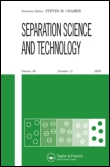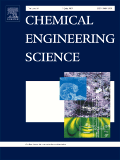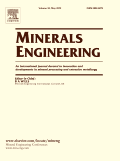
SEPARATION SCIENCE AND TECHNOLOGY
Scope & Guideline
Elevating Knowledge in Separation Processes
Introduction
Aims and Scopes
- Separation Processes:
The journal deals with various separation processes including extraction, filtration, flotation, distillation, and membrane technologies, emphasizing the underlying principles and advancements in these methodologies. - Environmental Remediation:
A significant portion of the research focuses on the removal of pollutants, heavy metals, and contaminants from water and soil, highlighting innovative methods and materials for environmental cleanup. - Material Development:
The development and characterization of new materials such as adsorbents, membranes, and nanocomposites for enhanced separation efficiency are central themes, showcasing novel approaches to improve separation performance. - Analytical Techniques:
The journal publishes studies on analytical methodologies that support separation processes, including spectroscopy, chromatography, and other techniques for the detection and quantification of target compounds. - Thermodynamics and Kinetics:
Research exploring the thermodynamic and kinetic aspects of separation processes is prevalent, providing insights into the mechanisms governing separation efficiency and effectiveness.
Trending and Emerging
- Green and Sustainable Technologies:
A growing trend towards environmentally friendly separation processes is evident, with an emphasis on using biodegradable materials, less hazardous solvents, and energy-efficient methods to minimize environmental impact. - Nanotechnology in Separation Science:
Research incorporating nanomaterials and nanotechnology is on the rise, as these materials offer enhanced surface area, reactivity, and specificity for various separation applications, particularly in water treatment and pollutant removal. - Integration of Advanced Analytical Techniques:
There is an increasing trend in the integration of advanced analytical techniques with separation processes, allowing for real-time monitoring and optimization of separations, which enhances efficiency and product quality. - Biological and Bioremediation Approaches:
Emerging research focuses on the application of biological methods and bioremediation for separation and recovery processes, showcasing innovative uses of microorganisms and natural materials for environmental remediation. - Computational Modeling and Simulation:
The use of computational methods for modeling and simulating separation processes is gaining traction, providing researchers with powerful tools for optimizing process conditions and understanding complex phenomena.
Declining or Waning
- Traditional Solvent Extraction:
There has been a noticeable decrease in papers focusing on traditional solvent extraction methods as researchers increasingly explore greener and more innovative extraction techniques such as supercritical fluid extraction and ionic liquid-based methodologies. - Conventional Adsorbents:
Research on conventional adsorbents, while still relevant, is declining in favor of studies involving advanced materials such as nanocomposites and functionalized adsorbents that offer superior performance and specificity. - Single-Component Separation Techniques:
There is a waning interest in studies that focus solely on single-component separations, with more research being directed towards multi-component separations and complex mixtures, reflecting the need for more comprehensive solutions in real-world applications.
Similar Journals

CHEMICAL ENGINEERING SCIENCE
Advancing the Frontiers of Chemical Engineering InnovationChemical Engineering Science is an esteemed journal published by Pergamon-Elsevier Science Ltd, dedicated to advancing the field of chemical engineering through high-quality research and innovation. With a storied history spanning from 1951 to 2025, this journal is recognized as a leading platform for disseminating cutting-edge studies, encompassing a diverse range of topics within chemical engineering, applied mathematics, and industrial engineering. Notably, it holds a prestigious Q1 ranking in several categories, including Chemical Engineering and Industrial and Manufacturing Engineering, indicating its significant impact and influence in these fields. The journal is not open access, yet it maintains a robust readership and is widely cited in academic circles, reflecting its vital role in shaping modern engineering practices. As a vital resource for researchers, professionals, and students alike, Chemical Engineering Science continues to bridge theoretical concepts and practical applications, fostering a deeper understanding of the complex challenges in chemical processes and manufacturing.

CHEMICAL AND BIOCHEMICAL ENGINEERING QUARTERLY
Fostering Collaboration in Chemical Engineering ExcellenceCHEMICAL AND BIOCHEMICAL ENGINEERING QUARTERLY, published by the Croatian Society of Chemical Engineering Technology, is a distinguished open-access journal that has been providing a platform for the dissemination of innovative research since its inception in 1987. With a focus on the fields of biochemistry and chemical engineering, this quarterly journal addresses a wide array of topics, including process chemistry and technology, making significant contributions to both academia and industry. Despite its current positioning in the Q4 category for biochemistry and Q3 for miscellaneous chemistry and process chemistry in 2023, the journal continues to strive for greater impact, catering to researchers, professionals, and students alike. Its open-access model, in place since 2001, ensures that cutting-edge research is accessible to a broad audience, fostering collaboration and knowledge sharing within the scientific community. By promoting high-quality research and providing insights into the latest advancements, Chemical and Biochemical Engineering Quarterly remains an essential resource for those involved in the chemical and biochemical engineering disciplines.

CHEMICAL ENGINEERING COMMUNICATIONS
Unveiling Innovations in Chemical Engineering.Chemical Engineering Communications, published by Taylor & Francis Inc, is a distinguished journal within the realms of Chemical Engineering and Chemistry. With an ISSN of 0098-6445, this journal plays a pivotal role in disseminating innovative research, critical reviews, and insightful discussions that encompass a broad spectrum of topics in these fields. The journal boasts a commendable Q2 ranking in the 2023 category of chemical engineering and general chemistry, reflecting its significant contribution to the scientific community. Operating under a rigorous peer-review process, the journal attracts high-quality submissions from global researchers. Although currently not an Open Access journal, it provides extensive archive access for users interested in exploring past advancements from its inception in 1973 through to 2024. With a commitment to advancing knowledge and fostering collaboration among academia and industry, Chemical Engineering Communications remains an essential resource for professionals and students aiming to stay abreast of the latest developments in chemical sciences.

Bulletin of Chemical Reaction Engineering and Catalysis
Exploring Breakthroughs in Chemical Reaction DynamicsBulletin of Chemical Reaction Engineering and Catalysis is a distinguished open-access journal published by UNIV DIPONEGORO, focusing on pivotal advancements in the fields of chemical reaction engineering and catalysis. Since its inception in 2008, this journal has served as a vital platform for disseminating cutting-edge research, catering to a diverse readership that includes researchers, professionals, and students in chemical engineering and related disciplines. With its dedication to publishing valuable insights, the journal has been indexed in Scopus and boasts respectable rankings across various categories, including Q3 in Chemical Engineering (miscellaneous) and Q4 in Catalysis as of 2023. It continues to foster scholarly dialogue and collaboration by providing an accessible means for contributors to share their findings. Operating from Semarang, Indonesia, this journal underscores its commitment to advancing knowledge in chemical sciences, making it an essential resource for those engaged in the study and application of chemical processes.

MINERALS ENGINEERING
Exploring the Frontiers of Geotechnical EngineeringMINERALS ENGINEERING, an esteemed journal published by PERGAMON-ELSEVIER SCIENCE LTD, is at the forefront of disseminating cutting-edge research in the fields of minerals processing, geotechnical engineering, and control systems. Since its inception in 1988, this journal has become a pivotal platform for researchers, professionals, and students alike, offering insights and advancements that contribute significantly to both academia and industry. With a strong emphasis on interdisciplinary approaches, MINERALS ENGINEERING is ranked in the top quartile (Q1) for multiple engineering categories, including Mechanical Engineering and Geotechnical Engineering, highlighting its relevance and influence in the global scientific community. Although not an open access journal, it provides comprehensive analyses and robust methodologies that are critical for advancing technological innovations and environmental sustainability within engineering. Researchers can rely on this journal to stay informed about the latest developments, trends, and challenges they face in the field, ensuring they are at the forefront of minerals engineering research.

CHEMICAL AND PETROLEUM ENGINEERING
Pioneering Discoveries in Chemical and Petroleum SciencesChemical and Petroleum Engineering is a prestigious academic journal dedicated to the advancement of knowledge in the fields of chemical engineering and petroleum technologies. Published by Springer, this journal serves as a vital resource for researchers, professionals, and students interested in the intricate processes and innovations that drive these industries. With an ISSN of 0009-2355 and an E-ISSN of 1573-8329, it has established a notable presence since its inception in 1965. Throughout its converged years, the journal has continually published impactful research that contributes to sustainability and efficiency within the sectors. Although it holds a Q3 ranking in Chemical Engineering and Fuel Technology and a Q4 ranking in Energy Engineering and Geochemistry, it is a noteworthy platform for emerging studies, fostering connections among scholars. Readers will find a wealth of information and ideas, but please note that this journal does not currently offer open access options. For those passionate about chemical and petroleum engineering, this journal is an essential part of staying informed and engaged with the latest scientific advancements.

Membranes and Membrane Technologies
Transforming Industries Through Membrane TechnologiesMembranes and Membrane Technologies is an innovative journal dedicated to advancing the fields of chemical engineering, chemistry, and materials science through the exploration of membrane science and technology. Published by PLEIADES PUBLISHING INC, this journal offers vital insights into the efficient design, synthesis, and application of membranes across diverse industries, aiming to enhance water treatment, energy generation, and various separation processes. With an ISSN of 2517-7516 and an E-ISSN of 2517-7524, the journal is recognized for its impactful contributions, holding a Q3 category ranking in multiple fields as of 2023. Researchers and professionals will find a wealth of open-access articles that promote the sharing of knowledge and foster collaboration in this rapidly evolving domain. As it converges its mission from 2019 to 2024, Membranes and Membrane Technologies remains an essential resource for those committed to pushing the frontiers of membrane research and application.

International Journal of Coal Preparation and Utilization
Advancing sustainable energy solutions through coal research.The International Journal of Coal Preparation and Utilization, published by Taylor & Francis Inc, serves as a pivotal platform dedicated to advancing research and knowledge in the fields of coal preparation and utilization. Since its inception in 1999, the journal has maintained a strong commitment to facilitating scholarly discourse among professionals and researchers engaged in coal technology, energy engineering, and environmental concerns. With a solid reputation reflected in its Q2 quartile rankings across multiple categories including Chemical Engineering, Energy Engineering and Power Technology, and Geotechnical Engineering, this journal continues to make significant contributions to the understanding and application of coal and its related technologies. The journal provides both subscription and open access options, ensuring wide accessibility to its rich repository of peer-reviewed articles. As the industry evolves, the International Journal of Coal Preparation and Utilization remains vital for stakeholders interested in the innovative practices that promote sustainable energy solutions.

CHEMICAL ENGINEERING RESEARCH & DESIGN
Catalyzing Progress in Chemical Research and Application.CHEMICAL ENGINEERING RESEARCH & DESIGN is a prestigious journal that has been at the forefront of dissemination in the fields of chemical engineering and general chemistry since its inception in 1983. Published by Elsevier, the journal features a rich array of research articles that contribute to both theoretical and practical advancements in the discipline. With an impact factor that positions it strongly within the Q2 quartile for both Chemical Engineering and Chemistry categories, it occupies an esteemed place in the academic community, being ranked #77 out of 273 in Chemical Engineering and #111 out of 408 in General Chemistry on Scopus. Researchers and professionals will find it an invaluable resource for cutting-edge research and innovative methodologies that shape the future of chemical engineering applications. While the journal does not currently offer open access, it remains accessible through institutional subscriptions, ensuring that important findings continue to reach a broad audience. With a scope that is poised to expand through 2024, the journal aims to foster collaboration and knowledge sharing, supporting the continuous evolution of the field.

Journal of Industrial and Engineering Chemistry
Driving Excellence in Chemical Engineering ResearchThe Journal of Industrial and Engineering Chemistry, published by Elsevier Science Inc, stands as a premier platform since its inception in 1996, dedicated to the dissemination of innovative research in the field of Chemical Engineering. Located in South Korea, this influential journal has established itself with an impressive impact factor and is categorized in the Q1 quartile for chemical engineering (miscellaneous), ranking in the top 12% of its category according to Scopus. With a focus on cutting-edge industrial applications, the journal covers a diverse range of topics including chemical processes, engineering innovations, and sustainable practices, appealing to a broad spectrum of researchers, professionals, and students. Although currently not open access, the journal offers a wealth of resources for advancing knowledge and driving forward the chemical engineering discipline. The converged years from 1996 to 2024 reflect its ongoing commitment to excellence and timeliness in publishing high-quality research.